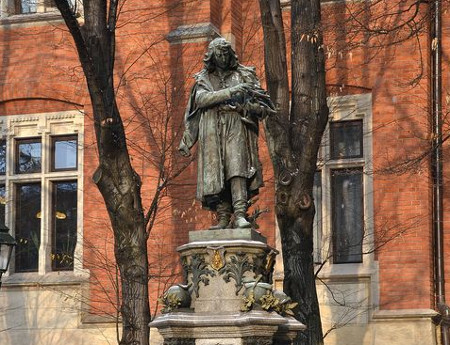
Nicolaus Copernicus studied in Kraków and he frequently returned here. The capital of the Małopolska voivodeship is filled with priceless treasures connected to the astronomer. Just by walking around Kraków’s Old Town one can see the intellectual and material heritage that Nicolaus Copernicus has left behind.
There are numerous places in Kraków that bear witness to Copernicus’ legacy in the city. Below are just several of them, mostly located not too far from the Market Square.
- University Quarter and Collegium Maius (ul. Jagiellońska 15): The JU Museum has a number of exhibits related to Nicolaus Copernicus, such as astronomical devices, books and paintings. As the oldest University building, it was the place where the astronomer received his education; he also probably lived close by.
- Jagiellonian Library (al. Mickiewicza 22): The Library safeguards the manuscript of De revolutionibus orbium coelestium.
- Planty Park outside JU Collegium Novum (ul. Gołębia 9): A statue of Copernicus from 1900 sculpted by Cyprian Godebski (1835–1909) is displayed here.
- JU Collegium Novum (ul. Gołębia 9): Jan Matejko’s painting Astronomer Copernicus, or Conversations with God is displayed in the Collegium Novum assembly hall
- Jan Matejko’s House Museum (ul. Floriańska 41): The collection features a sketch for the abovementioned painting (1871).
- St. Anne’s Collegiate Church (ul. św. Anny): The church houses a statue of Copernicus sculpted in 1822 by Kazimierz E. Galli at the request of Reverend Sebastian Sierakowski.
- The Princes Czartoryski Museum (ul. Pijarska 15): The Museum houses the astronomer’s sarcophagus from 1856.
- Polish Academy of Arts and Sciences (ul. Sławkowska 17): There is a statue of Copernicus sculpted in 1872 by Walery Gadomski (1833–1911) funded by Adam Potocki.
- JU Collegium Śniadecki (ul. Kopernika 27): Astronomical observatory founded by Jan Śniadecki in 1791. There is a bust of Nicolaus Copernicus in the lecture hall.
- JU Astronomical Observatory (ul. Orla 171): The new JU observatory bears the name of Nicolaus Copernicus. It features a sculpture of the astronomer by Konstanty Laszczka (1865–1956) and two portraits by Anna Szymborska and Zdzisław Pabisiak.
- Henryk Jordan Park (al. 3 Maja): Amongst numerous busts of distinguished Poles there is also one depicting Copernicus.
- Wieliczka Salt Mine: The mine houses a statue of Copernicus made of salt.
- Observations of Mars and Moon: During clear night, it is possible to look for Copernicus’ legacy on our neighbouring celestial bodies, as there are quite large craters named after Copernicus on Mars and Moon.

